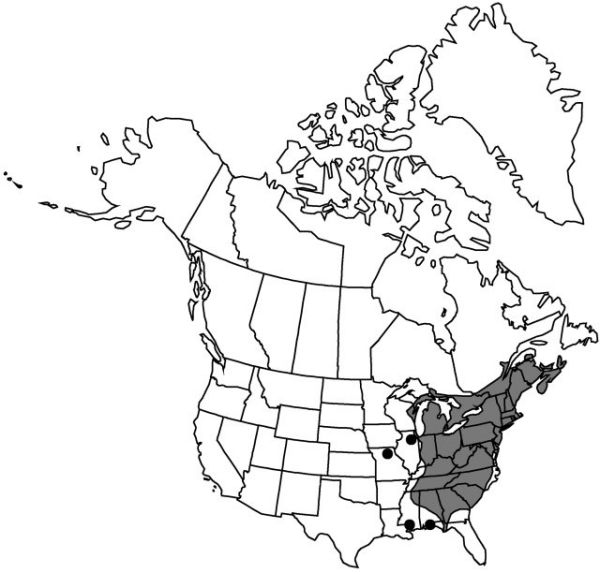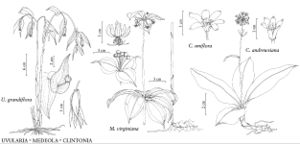Difference between revisions of "Medeola virginiana"
Sp. Pl. 1: 339. 1753.
FNA>Volume Importer |
imported>Volume Importer |
||
| (6 intermediate revisions by 2 users not shown) | |||
| Line 6: | Line 6: | ||
|place=1: 339. 1753 | |place=1: 339. 1753 | ||
|year=1753 | |year=1753 | ||
| + | }} | ||
| + | |special_status={{Treatment/ID/Special_status | ||
| + | |code=F | ||
| + | |label=Illustrated | ||
| + | }}{{Treatment/ID/Special_status | ||
| + | |code=E | ||
| + | |label=Endemic | ||
}} | }} | ||
|basionyms= | |basionyms= | ||
| Line 23: | Line 30: | ||
|elevation=0–1600 m | |elevation=0–1600 m | ||
|distribution=N.B.;N.S.;Ont.;P.E.I.;Que.;Ala.;Conn.;Del.;D.C.;Fla.;Ga.;Ill.;Ind.;Ky.;La.;Maine;Md.;Mass.;Mich.;Miss.;Mo.;N.H.;N.J.;N.Y.;N.C.;Ohio;Pa.;R.I.;S.C.;Tenn.;Vt.;Va.;W.Va.;Wis. | |distribution=N.B.;N.S.;Ont.;P.E.I.;Que.;Ala.;Conn.;Del.;D.C.;Fla.;Ga.;Ill.;Ind.;Ky.;La.;Maine;Md.;Mass.;Mich.;Miss.;Mo.;N.H.;N.J.;N.Y.;N.C.;Ohio;Pa.;R.I.;S.C.;Tenn.;Vt.;Va.;W.Va.;Wis. | ||
| − | |discussion=<p>The rhizome of Medeola virginiana has the taste and odor of cucumber and is edible. The whorled leaves look like those of the orchid Isotria verticillata. The Iroquois of eastern North America used M. virginiana as an anticonvulsive, pediatric aid (D. E. Moerman 1986).</p> | + | |discussion=<p>The rhizome of <i>Medeola virginiana</i> has the taste and odor of cucumber and is edible. The whorled leaves look like those of the orchid <i>Isotria verticillata</i>. The Iroquois of eastern North America used <i>M. virginiana</i> as an anticonvulsive, pediatric aid (D. E. Moerman 1986).</p> |
|tables= | |tables= | ||
|references= | |references= | ||
| Line 32: | Line 39: | ||
-->{{#Taxon: | -->{{#Taxon: | ||
name=Medeola virginiana | name=Medeola virginiana | ||
| − | |||
|authority=Linnaeus | |authority=Linnaeus | ||
|rank=species | |rank=species | ||
| Line 46: | Line 52: | ||
|publication title=Sp. Pl. | |publication title=Sp. Pl. | ||
|publication year=1753 | |publication year=1753 | ||
| − | |special status= | + | |special status=Illustrated;Endemic |
| − | |source xml=https:// | + | |source xml=https://bitbucket.org/aafc-mbb/fna-data-curation/src/2e0870ddd59836b60bcf96646a41e87ea5a5943a/coarse_grained_fna_xml/V26/V26_242.xml |
|genus=Medeola | |genus=Medeola | ||
|species=Medeola virginiana | |species=Medeola virginiana | ||
Latest revision as of 21:14, 5 November 2020
Rhizomes 3–8 × 1 cm, decaying every year. Stems 2–9 dm, white-woolly when young, 1–3 deciduous bracts below proximal leaf whorl. Leaf blades sessile or short-petiolate, becoming purple-tinged basally in fruit, 5–9(–12) in proximal whorl, 6–16 × 1.5–5 cm, 3(–5) in distal whorl, 2.5–5 × 1.5–4 cm. Tepals yellowish green, 6–10 mm. Fruits (5–)8–10(–14) mm diam. Seeds 3 mm. 2n = 14.
Phenology: Flowering late spring.
Habitat: Moist slopes, mesic woods
Elevation: 0–1600 m
Distribution

N.B., N.S., Ont., P.E.I., Que., Ala., Conn., Del., D.C., Fla., Ga., Ill., Ind., Ky., La., Maine, Md., Mass., Mich., Miss., Mo., N.H., N.J., N.Y., N.C., Ohio, Pa., R.I., S.C., Tenn., Vt., Va., W.Va., Wis.
Discussion
The rhizome of Medeola virginiana has the taste and odor of cucumber and is edible. The whorled leaves look like those of the orchid Isotria verticillata. The Iroquois of eastern North America used M. virginiana as an anticonvulsive, pediatric aid (D. E. Moerman 1986).
Selected References
None.
